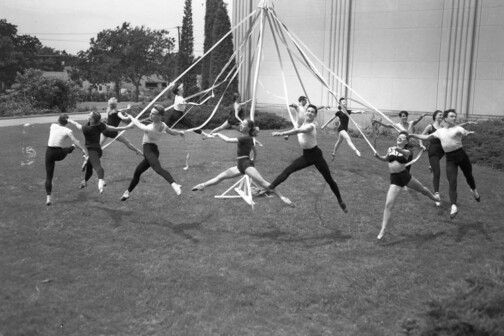For Miles, it’s not about winning or losing fights with the paper. It’s that there is always a fight to win or lose. As he picks at his breakfast, he walks through an example. He and his staff are aware of a rumor regarding the district’s executive directors all being required to reapply for their jobs—which, by the way, is not true. And he knows if it is reported—even as a rumor—it will cause panic.
From there, the dominos will all fall the way they often do: the story based on the rumor leads to a story based on the drama it is causing, which leads to a story based on reaction to the rumor and the drama, which leads to an official response from Miles and his staff, which leads to a story about the people who don’t buy the official response. If they are lucky, it ends there. But it doesn’t always. They ended up avoiding the cycle this time, but you can see this sequence following other non-news events in the Dallas Morning News archives and on its education blog.
“Okay, so we just generated, you know, five or six stories—and it seems like, okay, things must be in chaos, and leadership doesn’t know what they’re doing, and they’re going to fire all these people,” Miles says. “And it’s absolutely not true. I don’t even know where the rumor comes from. I don’t know if I’ll ever get used to that.”
A more legitimate reason the district may seem like it is in chaos: the board of trustees’ investigation into allegations that Miles violated his contract and worked to publicly disparage the board via former operations chief Kevin Smelker’s resignation letter—especially how that soap opera played out in the media.
But Miles says he expects the board to approve his plan for a performance-based pay structure for teachers and a new evaluation system to go with it when he officially presents it at his May briefing. Just like they approved his new principal evaluation system last school year. While acknowledging problems in “tertiary areas,” Mayor Rawlings says the board has provided “air cover” to allow Miles to focus on getting his principals and teachers on track, which is how they’ll get the students on track, which is his job. It can be a messy process, but it’s working.
“He could have made nice and waited,” Rawlings says. “But we can’t wait around and do nothing.”
Okay, so the board and Miles are working together. But what about where it really counts? Has Miles’ time in Dallas resulted in a “lack of collaboration and communication” at the district’s campuses, as Linda Isaacks, executive director of the Dallas School Administrators Association, claimed in an op-ed in the Dallas Morning News in September?
Let’s go see.
• • •

It’s another cold morning, this one in early February. Miles was up at 3 and then again at 4:30, taking calls to determine if school would be canceled because of a recent snowfall. He got up for good at 5:15, his normal wake-up time during the week. Now, a little after 8, he walks out of his office ready to hit the road, wearing a black overcoat over his blue suit.
This morning, he has a few school visits planned. They are a surprise to everyone except Miles’ special assistant, Justin Coppedge, who knows the locations beforehand. “I have a running list of all the ones we haven’t visited yet,” Coppedge says, “and I look at the schedule and how much time we have and where we need to end up.” We get in the back seat of Coppedge’s Ford Expedition, and he tells Miles where we’re going first: Jill Stone Elementary in Vickery Meadow. Three fellows from the district’s Leadership Development Fellows Academy are tagging along.
Miles spent the weekend looking over numbers—the results of the school’s mid-year reviews and the UNT-administered climate surveys, and the students’ Assessments of Course Performance (ACP) exams. “That gives us a data point for this time of the year,” he says. “And, you know, overall, in all three areas, the district got better. Slow movement in the right direction.”
He knows the numbers. What he wants to see on these visits is how the schools got them, how teachers are instructing the students. But that’s not happening at Jill Stone today. The kids are taking interim assessment tests—something Miles did away with, but schools in the Conrad High School feeder pattern decided they needed. He stops by a few classes anyway, but keeps his visit short. We get back in the SUV and head to the next school: Dan D. Rogers Elementary.
Miles says the magic words into the intercom at the main entrance—“I’m here to see about instruction”—and is greeted by principal Lisa Lovato, assistant principal Angela Bell, and the school’s instructional coach, Fabian Vera. Last school year, the district gave principals the option to hire instructional coaches, but before this term started, Miles required all campuses to hire one. “Backstop is a good way to phrase it,” he says. It’s something Miles wishes he had when he was a teacher—someone on hand to help him improve, to turn to for support.
“The instructional coach has been one of the better-received initiatives,” he says. “Teachers have found out that, wow, these people are helpful. The principals have found out, wow, they really do what they’re talking about. It’s turned out to be a pretty good investment. And it shows that teachers and principals generally don’t mind if it’s an aid, if it’s a help, if it’s going to be positive.”
Lovato seems a bit nervous as she leads Miles around the school, breathlessly explaining how Rogers Elementary has used data-driven instruction to improve, a blur of acronyms and jargon.
“As long as it doesn’t disrupt what we already have, if we think it makes sense, it makes us better, we use it,” she says. She talks about spreadsheets and deep-dive analysis, performance predictions and congruency. Miles asks questions—making sure he understands, not critiquing.
Lovato takes Miles to a pair of fifth-grade classrooms, and he clearly enjoys being around the students, asking questions, looking over their work—teaching. He can’t help himself. When he leaves each class, he discusses with Lovato the positives before offering feedback on how the teachers could improve, making sure to return to the strengths again before moving on.
Coppedge tells Miles they don’t have time to stop at a third campus, so he extends his stay at Rogers, spending some time in the lower grade levels. Before exiting the building, Miles stops and writes a short note to each teacher he observed delivering strong instruction, thanking them for their time and offering a word of encouragement. Then it’s time to go. On the way out, Lovato stops Miles so she can introduce him to her daughter, who is also one of her students.
Back in the SUV, Miles says he expects Rogers to become a great school—in terms of achievement—in the next few years, because of the culture and climate Lovato has created. And that culture exists because Miles expects it of his principals. As Coppedge drives us down Central Expressway, back to 3700 Ross Avenue and the rest of a long day, he explains that his first two years have been all about laying the foundation—not just systems and processes, but expectations and beliefs.
“So while you’re doing all that, it’s not like you’re going to go up like this”—he motions his hand upward, a rocket launching from his knee—“because it can take a while. And, you know, there’s some disruption and there are some people who are resistant. But most people—with good coaching and good principals—are going to move forward and progress. And that’s exactly what you see.”
After Miles and Coppedge drop me off, I realize the morning was, in some ways, a bit of theater. Because I am along for the ride, with a photographer in tow, there is a better than good chance that I saw a “school visit” and not a normal school visit. But if it was a performance, the staff at the schools sure didn’t know. And more to the point, I think what Miles said in those first days is true, even if he is careful not to say it anymore. He is not going to make decisions based on media coverage. He doesn’t give a damn what I think. He only cares about the kids’ futures.
I believe that because he’s a cornball. And cornballs don’t change. Cue Whitney Houston.






